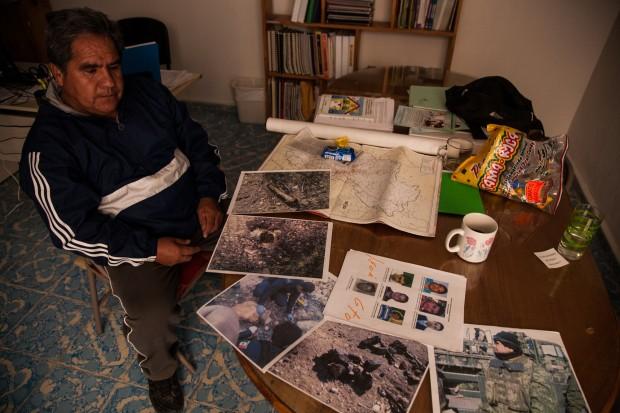In Mexico, family members left to investigate disappearances of loved ones
Jose Luis Cordero sits with some of the evidence he has collected over the two years of researching the disappearance of his brother, Ernesto Cordero. (Photo by Myles Estey.)
Some 249 people have disappeared in Mexico over the past six years, according to a new report published by the group Human Rights Watch.
The report says in 149 of those cases, there’s compelling evidence showing the involvment of government security forces. It also accuses the Mexican government of failing to investigate these cases properly.
One case highlighted in the report involves 10 hunters from Guanajuato who went missing in December 2010, Ernesto Cordero among them.
His brother, Jose Luis Cordero, has been investigating the case on his own.
One key bit of evidence he’s relied on is video from a camera that belonged to one of the hunters. It shows footage of one of the missing men, standing in the desert, cradling a deer. There are also scenes of the friends joking around on their hunting trip.
Then the video cuts to scenes from inside a house. The video’s eerie green glow resembles night vision. Different men come in and out of the frame. Automatic weapons and rifles litter the couches, and some of the men carry handguns.
The camera and its footage were found in a raid of the house seen in the video. Officials say the men inside the house were the presumed kidnappers, members of the Zetas drug cartel.
According to the authorities, the men in the house had already killed most of the hunters when they themselves were killed in a shootout with Army soldiers.
But, as is often the case in Mexico, the details remain murky.
But Jose Luis Cordero believes the hunters were detained by corrupt police officers, who were allied with organized crime.
“You can see the gas station where they were taken,” Cordero said, as he narrated a grainy security video that shows police trucks and unmarked SUVs.
Jose Luis said he believes his brother and the other hunters were inside those police trucks. One friend who later escaped, and a minor who was let go, identified the gas station and recounted other details of the ordeal.
The survivors said the hunters were driven around after being kidnapped, and spent the night in a police station. The next day, they say the police handed the hunters over to the criminals in the SUVs seen on that security video.
Witnesses said they were beaten and threatened, then driven to an abandoned patch of desert. Sensing danger, the man who escaped managed to run away. When he last looked back, he says he heard gunshots, and later saw a fire. But he was too far away to be sure.
“We have authorities whose job it is to investigate, but they are not investigating,” said Angeles Lopez, who runs a women’s rights organization in Leon, and has become a source of support for the families in this case.
She said there’s a clear reason why the authorities don’t follow through.
“They’re scared, because they’re incapable, or in many cases, because they’re complicit. No one knows where organized crime ends, and where the state begins, because a lot of the time, they’re the same,” Lopez said.
Across Mexico, these shortcomings leave family members like Jose Luis Cordero in charge of their own investigations. He’s the one pursuing leads and drawing information onto topographic maps he’s purchased.
Cordero’s risky detective work has alerted authorities to the remains of dozens of bodies.
But not those of his brother or nephew, who was also on that hunting trip.
Zacatecas state prosecutor Arturo Nahle laments that so much about this case remains a mystery. But he believes the hunters were mistaken for members of a rival cartel poking around in Zeta territory, picked up by corrupt police officers, and killed on that suspicion alone.
But he is certain those responsible are either dead or in jail.
“We have no doubt that the police officers who are in jail are those who participated in the kidnapping of the hunters from Guanajuato,” Nahle said. “And we have no doubt that the Zetas who were killed by the Army were the ones who killed the hunters, beacuse they had their belongings.”
Yet, the only evidence families say they’ve seen is a vial of dust, supposedly the crushed up vertebrae of Ernesto Cordero, found amid the remains of some 30 other bodies in the desert.
They were shown no documentation of how or where it was found, just told to accept that justice was served, and move on.
“It would be better to know that they were dead, that would be fine,” said Jenny Romero Manrique, Ernesto Cordero’s wife. “At least we’d know they were resting, and we could rest too. But the uncertainty of not knowing if they’re alive, if they are eating, if they’re cold, or if they’re being forced to work like slaves somewhere, that’s just torture.”
Manrique and family members of the other victims say they’re hopeful that, under Mexico’s new president, there will be an effort to find out what really happened to Mexico’s disappeared.
But for now, they’re waiting for any kind of definitive answer.
We want to hear your feedback so we can keep improving our website, theworld.org. Please fill out this quick survey and let us know your thoughts (your answers will be anonymous). Thanks for your time!
